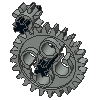| Welcome, Guest |
You have to register before you can post on our site.
|
| Forum Statistics |
» Members: 5,518
» Latest member: bthomasz
» Forum threads: 6,295
» Forum posts: 52,503
Full Statistics
|
| Online Users |
There are currently 203 online users.
» 0 Member(s) | 199 Guest(s)
Baidu, Bing, Google, Yandex
|
| Latest Threads |
Promotional Sets 2025
Forum: Official Models
Last Post: Philippe Hurbain
7 hours ago
» Replies: 7
» Views: 5,456
|
About size of flattened s...
Forum: Official File Specifications/Standards
Last Post: Philippe Hurbain
2025-12-17, 7:06
» Replies: 10
» Views: 366
|
Would BrickLink Designer ...
Forum: Official Models
Last Post: Orion Pobursky
2025-12-16, 14:53
» Replies: 1
» Views: 464
|
Some help with part 5608 ...
Forum: Parts Authoring
Last Post: Peter Grass
2025-12-15, 5:48
» Replies: 1
» Views: 186
|
Parts Request: Ninjago Dr...
Forum: Part Requests
Last Post: Peter Grass
2025-12-14, 7:55
» Replies: 4
» Views: 516
|
Part Request Boat Pieces
Forum: Part Requests
Last Post: San
2025-12-13, 10:30
» Replies: 4
» Views: 374
|
Existing Part Edit Reques...
Forum: Parts Authoring
Last Post: SNIPE
2025-12-12, 19:33
» Replies: 157
» Views: 376,591
|
Technic 1990
Forum: Official Models
Last Post: Takeshi Takahashi
2025-12-10, 16:32
» Replies: 17
» Views: 23,291
|
Alternate, Mobile Friendl...
Forum: LDraw.org Announcements
Last Post: Orion Pobursky
2025-12-08, 18:53
» Replies: 2
» Views: 514
|
Request for sticker scan ...
Forum: Part Requests
Last Post: Sylvain Sauvage
2025-12-08, 13:40
» Replies: 3
» Views: 462
|
|
|
| Screenshots as attachment |
|
Posted by: Ben Supnik - 2014-01-12, 22:16 - Forum: Website Suggestions/Requests/Discussion
- No Replies
|
 |
Hi Y'all,
Sorry if this is RTFM, but:
Is there a way to post screenshots as attachments in the forum? Or could we get the .png extension as a legal attachment type? I can host pics on flickr or elsewhere but I hate to have external links go bad based on an external hosting service...
Cheers
Ben
|

|
|
| Is there something wrong with axle holes? |
|
Posted by: Roland Melkert - 2014-01-12, 20:08 - Forum: Parts Authoring
- Replies (12)
|
 |
Looking at the radius 4 parts (e.g antenna, tech flex axle endings)
In real life they fit the inside axle holes, but in our library the max radius to fit in axle holes is only 2.8284 LDU ( sqrt(2^2+2^2) ). This seems quite a big margin.
Is this on purpose or is ether the axle hole or the 4LDU bar stuff wrong but accepted over time?
Or I'm I missing something else?
|

|
|
| 973p32 some quastions |
|
Posted by: Stan Isachenko - 2014-01-12, 10:11 - Forum: Parts Authoring
- Replies (11)
|
 |
I found out that there is no 973p32 part in library. Part with that name has cream stripes. But bricklink and my eyes sayes that stripes are white. So is it mistake in library or i have to upload part with white stripes?
Also Datheader said 486 - wrong color (this is belt), so what is right color?
|

|
|
| Lpub .pdf export too big to be printed... |
|
Posted by: Fabrice Vion - 2014-01-12, 8:57 - Forum: LDraw File Processing and Conversion
- Replies (1)
|
 |
Hello all,
I made a building instruction with Lpub and I converted it to a pdf file to print it. But the pdf file genrated is too big to be printed. I used different computers, printers, pdf viewers (Acrobat reader, X-change, Foxit reader) but I was never able to print the instruction. Either the printing doesn't start or stops after a few pages.
Do you know a way to reduce pdf size or another way to export the instruction from Lpub ?
Thanks in advance,
Fabrice
|

|
|
| 2013/2014 LDraw.org Standards Committee (LSC) - Call for Nominations |
|
Posted by: Orion Pobursky - 2014-01-09, 23:05 - Forum: LDraw.org Announcements
- Replies (20)
|
 |
Hi folks,
Once more we are rather late with the nominations/election process...
The LDraw.org Standards Committee (LSC) is responsible for maintaining semi-regular internal discussions on pending file format issues, the overall progress of the LDraw file format and new or proposed developments made by different LDraw-based software authors. They adopt new official standards by voting on them, and publish documentation on LDraw.org following such a decision. The LSC has documented and will document past, current and future LDraw File Formats.
With revision 1.5 of the LSC Charter the number of seats is restricted to 4 since one seat is reserved for a current LDraw Library Administrator.
To be eligible for LSC membership, per the LSC Charter you must fulfil at least one of the following:
* Authored at least two LDraw parts subsequently released in an Official LDraw.org Parts Update
* Served as a reviewer on the Parts Tracker through at least 2 official parts updates, and posted at least 5 reviews in at least two updates since their initial participation
* Authored a software program that is compliant with either the LDraw 1.0.2 specs or another spec published by the LSC
* Petition for nomination as an LSC candidate approved by 2 current LSC members
* Petition for nomination as an LSC candidate made to the LSC by at least 5 others eligible to be LSC candidates
People can either self-nominate or nominate someone else. When nominating, please reference the person’s eligibility from the list above. For the LSC there is non need that another member of the community seconds the nomination.
Nominations MUST be posted in direct reply to this post to be counted, and must be online by 12:00 PM GMT February 14.
Voting for the elections will begin February 15, and end March 15. The LSC will officially change over on April 2nd, giving time to transition newly elected members into the committee.
Only LDraw organization members are permitted to vote in this poll. Since we have yet to implement a new membership system, we consider you a member if you have signed up for the forums and have an active account with a real name attached
Orion Pobursky
On behalf of the LDraw.org Steering Committee
|

|
|
| 2014/2015 LDraw.org Steering Committee: Call for Nominations |
|
Posted by: Orion Pobursky - 2014-01-09, 23:00 - Forum: LDraw.org Announcements
- Replies (28)
|
 |
Per the LDraw.org Bylaws at http://www.ldraw.org/article/268.html, Subsection
6.03(a), the 2013/2014 Steering Committee hereby calls for the community to
nominate individuals as candidates for the 2014/2015 Steering Committee[1].
Please post nominations in response to this message. Nominations will only be
recognized if they are in response to this message.
Only LDraw organization members are permitted to nominated or vote. Since we have
yet to implement a new membership system, we consider you a member if you have
signed up for the forums and have an active account with a real name attached
Per ss.6.03(a), you must specify the name of the person you are nominating,
along with your name. Another member of the community must second the nomination
in a reply, and the nominee must publicly accept the nomination in the same
channel (direct reply to the nomination or second) in order to be valid. If the
nominee does not accept, it will be assumed that he or she has declined, and
they will not be placed on the ballot.
Nominations will close at 11:59 PM GMT on 28 February 2013. This means that to
be listed on the ballot, a candidate must have been nominated, seconded and must
have formally stated acceptance by that time.
The Steering Committee will give sufficient notice of the election and election
procedures per ss.6.03(b).
NOTE: subsection 6.03(b) states that elections should take place before March 1.
We interpret this to mean that we will commence the election on March 1, but
since it is electronic, it will run for 2 weeks, just as last time. The exact
time and date of start and end will be announced sometime very close to (but
after) 0000 GMT March 1.
Again, thanks to all of you for your commitment to the goals of the
organization, and in working with us this year. Please, stay involved with
LDraw.org and keep it moving forward!
Orion Pobursky
On behalf of the LDraw.org Steering Committee
--
[1] Try not to confuse the LDraw.org Steering Committee (SteerCo) with the LDraw
Standards Committee (LSC). The Steering Committee sets the course for the LDraw
Organization while the Standards Committee deals with the LDraw File Format.
|

|
|
|